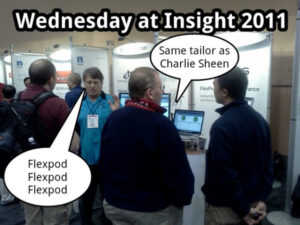
Today we talked about the issues that their customers have when deploying Flexpod solutions. There were three issues with near-universal approval:
1) "I thought I was buying one product. But now I have three monitoring tools."
Living with a FlexPod means jumping between Cisco UCS Manager, vCenter, and OnCommand, back and forth all day long, to check what's working right. Customers don't think that it looks like one product when it's in production.
2) "The business users need to know that I know where their stuff is running."
Business users are used to being able to touch the servers running their application. If there's a red light, they know there's a problem. With a shared infrastructure they aren't sure if there's a problem or not, and they're pretty sure that IT operations doesn't know either. They just don't have trust and confidence when it comes to sharing, and that means slower migration to fast, reliable Flexpod architectures.
3) "Shared infrastructure creates event storms whenever there's an issue. But which business users are affected, and what's the root cause?"
Because a shared infrastructure is built around relationships and dependencies, a single error in one place will often generate sympathetic events from many different components. With a Flexpod architecture that enables dynamic adjustments to changing demands, yesterday's relationships and dependencies are old news when it comes to diagnosing problems. IT operators need to know the "right now" infrastructure supporting business applications, and they need help sorting through the flood of events and picking out the most likely root cause. The new focus in IT ops is bringing applications to spec quickly, and fixing infrastructure problems afterwards.
Of course, the Zenoss Flexpod solution fixes all three of the problems.
One day to go, and we're looking forward to more spirited discussions!






